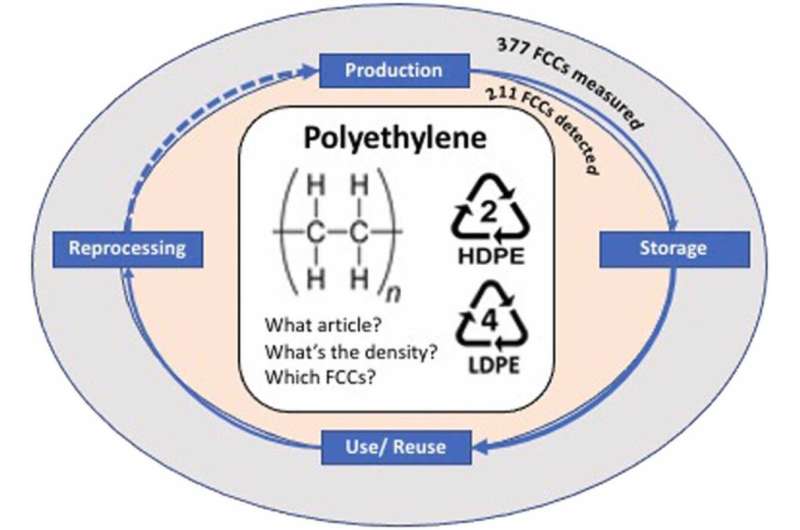This article has been reviewed according to Science X's editorial process and policies. Editors have highlighted the following attributes while ensuring the content's credibility:
fact-checked
peer-reviewed publication
trusted source
proofread
Recycled plastic food wrappers spark safety concerns

It keeps food fresh and clean, makes it easy to transport and tells you what's inside. Convenience is not a worry. But the chemicals recycled plastic food packaging carries are cause for concern, scientists warn.
Found in food trays, water bottles, containers, films, bags and more, polyethylene (PE) is the most-used plastic food packaging. Despite a Europe-wide pledge to recycle more of it, the risks of reusing secondary PE material in food contact packaging are far from clear.
Researchers at Brunel University London, University College London and Qatar University, working with the Food Packaging Forum, analyzed 116 studies into how PE packaging chemicals leach into the food and potentially be absorbed into the body.
The team identified 377 'food contact chemicals' in PE packaging, such as the bisphenol A and phthalates that can disrupt hormones and lead to health risks. Some 211of these 377 chemicals seep into food at least once during the plastic's life cycle. Alarmingly, only a quarter of those is authorized by EU regulation, a third of which are above the safe limit.
"The number of non-authorized chemicals was unexpectedly high," said Dr. Eleni Iacovidou, who lectures in environmental management. "This finding highlights the lack of traceability and harmonization of existing regulations."
"We found a lack of sufficient evidence to show PE can be safely recycled into new food-grade packaging," she said, explaining that many of the studies they looked at don't have enough detail such as what the bag or container is used for, how thick it is, how it would be stored and how many times it might be reused.
"Recycled PE is increasingly sought after in the production of new food-grade packaging, yet the quality of recycled PE poses critical questions from a chemical safety perspective," Dr. Iacovidou said.
Most of Europe's PE food packaging ends up in incinerators or landfill. In 2020 just 38 percent of it was recycled, and by 2030 Europe wants to up that to 55 percent.
"The EU and UK's commitment to increase packaging recycling demands a better understanding and monitoring of PE food packaging quality from a chemical perspective across the entire life cycle to enable the transition to a sustainable plastics value chain," said Dr. Iacovidou.
"Unpacking the complexity of the polyethylene food contact articles value chain: A chemicals perspective" is published in Journal of Hazardous Materials.
More information: Spyridoula Gerassimidou et al, Unpacking the complexity of the polyethylene food contact articles value chain: A chemicals perspective, Journal of Hazardous Materials (2023). DOI: 10.1016/j.jhazmat.2023.131422




















